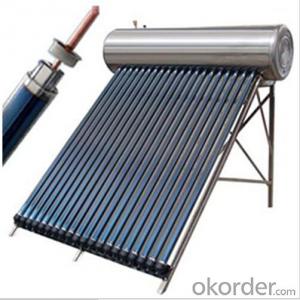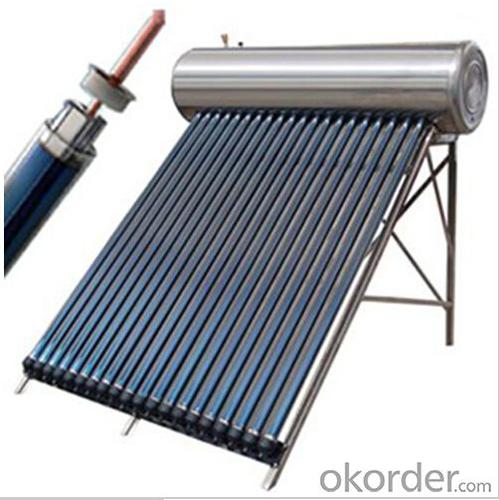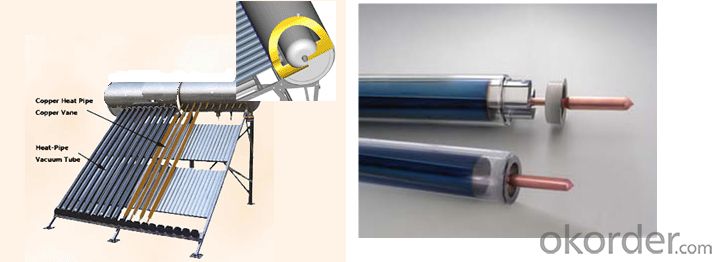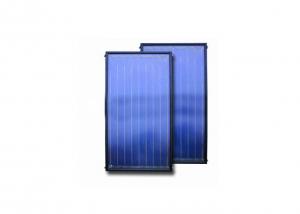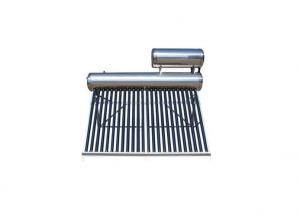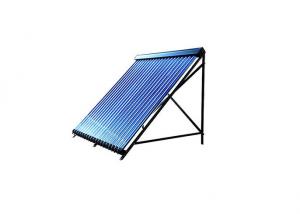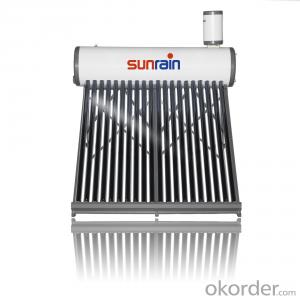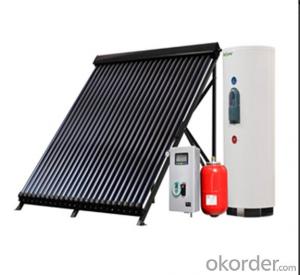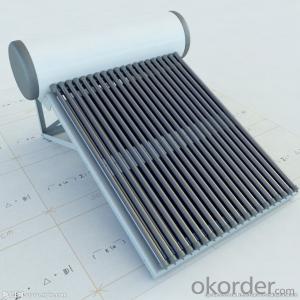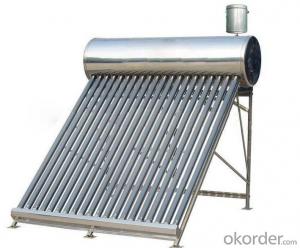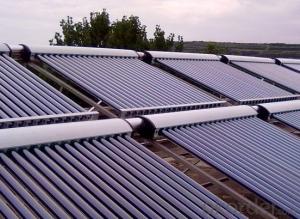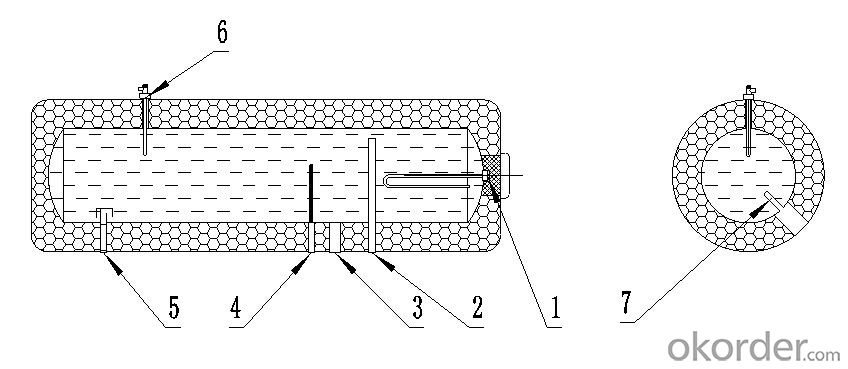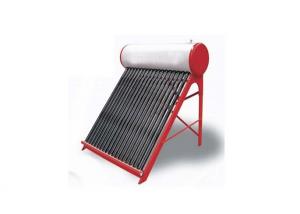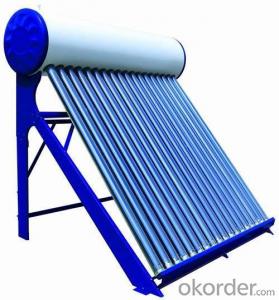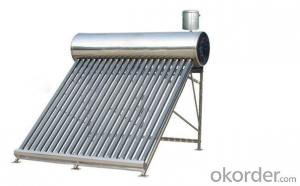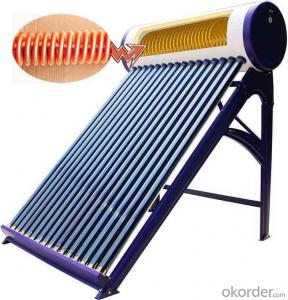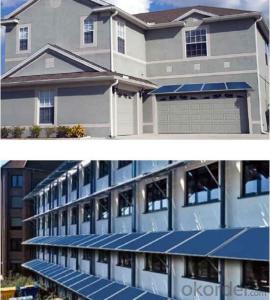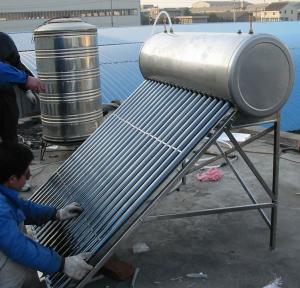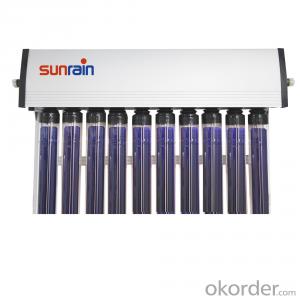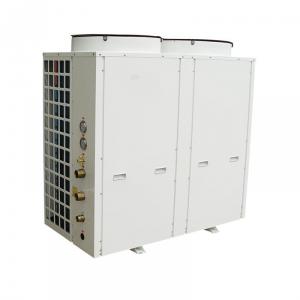Solar Water Heater 200 Ltr Price - Integrative Pressurized Stainless Steel Model SP-HS
- Loading Port:
- Shanghai
- Payment Terms:
- TT or LC
- Min Order Qty:
- 10 set
- Supply Capability:
- 2500 set/month
OKorder Service Pledge
OKorder Financial Service
You Might Also Like
Pressurized Stainless Steel Solar Water Heater Model SP-HS is composed by the following parts as shown in the graphic
1.Water inlet 2.Water outlet 3.P/T Valve 4.Electrical heater 5.Drain vent 6.Sensor hole 7. Heat exchange tube |
|
2.Main Features of the Pressurized Stainless Steel Solar Water Heater Model SP-HS:
(1)Glass vacuum tube solar collector, high temperature,antifreeze,vacuum insulation
(2)Copper heat pipe,Start up quickly,transfers heat quickly, low start-up temperature,low temperature resistant
(3) Food-grade stainless-steel SUS304 2B inner tank,full-automatic welding technology,under the protection of magnesium rod,it can increase of service life
(4)High pressure polyurethane foaming insulation,as the prefect density and the thermal conductivity coefficient is small, so it can provide effective heat preservation
(5)Gravity assisted heat pipe, unilateral heat transfer,high efficiency,low heat loss
3. Pressurized Stainless Steel Solar Water Heater Model SP-HS Images:
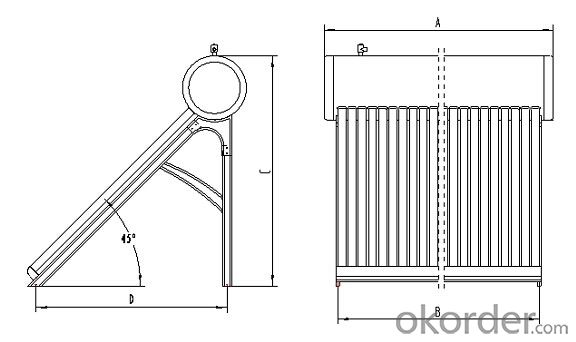
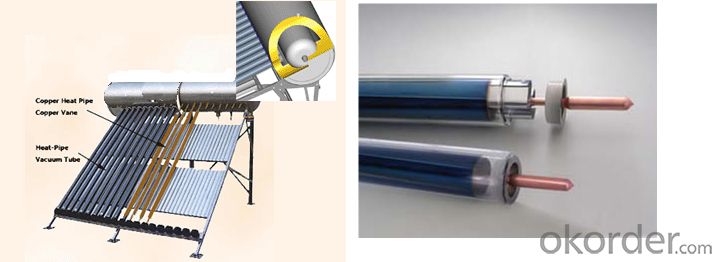
4. Pressurized Stainless Steel Solar Water Heater Model SP-HS Specifications:
Specification & model | SP-H-15 | SP-H-18 | SP-H-20 | SP-H-24 | SP-H-25 | SP-H-30 | ||
Tube QTY(pcs) | 15 | 18 | 20 | 24 | 25 | 30 | ||
Tube spacing㎜) | 75 | 75 | 75 | 75 | 75 | 75 | ||
WATER TANK | ||||||||
Net Volume of Storage Tank(L) | 125 | 145 | 160 | 190 | 200 | 235 | ||
Diamater of inner/outer Tank(㎜) | φ360/φ470 | φ360/φ470 | φ360/φ470 | φ360/φ470 | φ360/φ470 | φ360/φ470 | ||
material and thickness of inner tank(㎜) | SUS304 /t1.2 | SUS304 /t1.2 | SUS304 /t1.2 | SUS304 /t1.2 | SUS304 /t1.2 | SUS304 /t1.2 | ||
material of outer tank | stainless steel | stainless steel | stainless steel | stainless steel | stainless steel | stainless steel | ||
material of insulation | polyurethane | polyurethane | polyurethane | polyurethane | polyurethane | polyurethane | ||
Size of electrical heater hole | 11/4″ | 11/4″ | 11/4″ | 11/4″ | 11/4″ | 11/4″ | ||
Cold water inlet hole | 3/4″ | 3/4″ | 3/4″ | 3/4″ | 3/4″ | 3/4″ | ||
Hot water outlet hole | 3/4″ | 3/4″ | 3/4″ | 3/4″ | 3/4″ | 3/4″ | ||
T/P valve hole | 3/4″ | 3/4″ | 3/4″ | 3/4″ | 3/4″ | 3/4″ | ||
Drain vent hole and Magnisium hole | 3/4″ | 3/4″ | 3/4″ | 3/4″ | 3/4″ | 3/4″ | ||
Sensor hole | 1/2″ | 1/2″ | 1/2″ | 1/2″ | 1/2″ | 1/2″ | ||
Vacuum Tube | ||||||||
Diameter/Length(㎜) | φ58/1800 | φ58/1800 | φ58/1800 | φ58/1800 | φ58/1800 | φ58/1800 | ||
Material | High boron and silicon glass 3.3 | High boron and silicon glass 3.3 | High boron and silicon glass 3.3 | High boron and silicon glass 3.3 | High boron and silicon glass 3.3 | High boron and silicon glass 3.3 | ||
Outside thickness(㎜) | 1.8 | 1.8 | 1.8 | 1.8 | 1.8 | 1.8 | ||
Inside thickness(㎜) | 1.6 | 1.6 | 1.6 | 1.6 | 1.6 | 1.6 | ||
Light transmission rate | ≥0.90 | ≥0.90 | ≥0.90 | ≥0.90 | ≥0.90 | ≥0.90 | ||
Vacuum degree (Pa) | <10^-2 | <10^-2 | <10^-2 | <10^-2 | <10^-2 | <10^-2 | ||
Coating absorption | ≥0.90 | ≥0.90 | ≥0.90 | ≥0.90 | ≥0.90 | ≥0.90 | ||
Coating emittance | ≤0.07 | ≤0.07 | ≤0.07 | ≤0.07 | ≤0.07 | ≤0.07 | ||
Average heat loss coefficient | ≤0.75W/(㎡·℃) | ≤0.75W/(㎡·℃) | ≤0.75W/(㎡·℃) | ≤0.75W/(㎡·℃) | ≤0.75W/(㎡·℃) | ≤0.75W/(㎡·℃) | ||
Frame | 2 feets ( left-to-right ) | 3 feets ( left-middle-right ) | ||||||
Material | Galvanized steel t1.2 | Galvanized steel t1.2 | Galvanized steel t1.2 | Galvanized steel t1.2 | Galvanized steel t1.2 | Galvanized steel t1.2 | ||
Angle | 45° | 45° | 45° | 45° | 45° | 45° | ||
Tube support Specification/hole distance(㎜ | φ58/75 | φ58/75 | φ58/75 | φ58/75 | φ58/75 | φ58/75 | ||
Accessories: | ||||||||
Tube sealing ring | Silicon rubber/φ58 | Silicon rubber/φ58 | Silicon rubber/φ58 | Silicon rubber/φ58 | Silicon rubber/φ58 | Silicon rubber/φ58 | ||
Tube dusting rings | Silicon rubber/φ58 | Silicon rubber/φ58 | Silicon rubber/φ58 | Silicon rubber/φ58 | Silicon rubber/φ58 | Silicon rubber/φ58 | ||
Tube holder | ABS/φ58 | ABS/φ58 | ABS/φ58 | ABS/φ58 | ABS/φ58 | ABS/φ58 | ||
Item Size:: | ||||||||
a (㎜) | 1385 | 1610 | 1760 | 2060 | 2135 | 2510 | ||
b (㎜) | 1110 | 1335 | 1485 | 1785 | 1860 | 2235 | ||
c (㎜) | 1700 | 1700 | 1700 | 1700 | 1700 | 1700 | ||
c/2 (㎜) | —— | —— | —— | 892.5 | 930 | 1255 | ||
d (㎜) | 1430 | 1430 | 1430 | 1430 | 1430 | 1430 | ||
5. FAQ
(1). How do I protect my solar system during subzero temperatures?
If you have a system that is operating in areas with subzero temperatures then freeze protection must be implemented. The easiest means of preventing freezing is to use a controller with a low temperatures setting, so when the manifold temperature drops below a certain pre-set temperature (5oC/40oF), the pump will circulate, warming the collector with water from the bottom of the storage tank. The pump will not run continually, just periodically, the frequency of which will depend on the outside temperature. In extremely cold areas, a closed loop using a glycol/water mix may be appropriate.
(2). Will water be heated on a cloudy day?
Yes. Although the heat output of the solar collector is reduced on overcast days it will still be able to provide heating. If it is a heavily clouded day or raining, then more gas or electric boosting may be required to maintain water at the required temperature. This system will be automated so you don't have to worry about running out of hot water on a rainy day.
- Q: Are there any compatibility issues with using a solar water heater with existing plumbing systems?
- There can be compatibility issues when using a solar water heater with existing plumbing systems, but they are usually minimal and can be easily resolved. One potential issue is the size and capacity of the solar water heater compared to the existing plumbing system. Solar water heaters come in different sizes, and it is important to select one that matches the hot water usage requirements of the household. If the solar water heater is too small, it may not be able to meet the hot water demand, while if it is too large, it may cause pressure issues in the plumbing system. Another compatibility concern is the type of plumbing connections used in the existing system. Solar water heaters typically require specific fittings and connections to be installed properly. It is important to ensure that the existing plumbing system can accommodate these connections or make necessary modifications to ensure a proper fit. Additionally, the location of the solar water heater can also pose compatibility issues. Solar panels need to be installed in a spot that receives adequate sunlight throughout the day. If the existing plumbing system is located in a shaded area, it may not be suitable for installing a solar water heater. In such cases, alternative locations or modifications to the plumbing system may be required. Lastly, the age and condition of the existing plumbing system can also impact compatibility. Older systems may have worn-out pipes and fittings that may not be compatible with the solar water heater. In such cases, additional repairs or upgrades to the plumbing system may be necessary to ensure compatibility. Overall, while there can be compatibility issues with using a solar water heater with existing plumbing systems, they are typically not significant and can be resolved with proper planning, installation, and potentially some modifications to the plumbing system. It is always advisable to consult with a professional plumber or solar water heater installer to assess compatibility and ensure a smooth integration.
- Q: Can a solar water heater be used in areas with strict aesthetic requirements?
- Yes, a solar water heater can be used in areas with strict aesthetic requirements. There are various options available, such as integrating the solar panels into the existing architecture or using solar collectors that resemble traditional roofing materials. These design options ensure that the solar water heater blends in with the surrounding aesthetics, allowing for its installation even in areas with strict aesthetic guidelines.
- Q: How does the type of insulation used in a solar water heater impact its performance?
- The type of insulation used in a solar water heater significantly affects its performance. Good insulation helps to minimize heat loss, allowing the water to stay hot for longer periods. This results in improved efficiency and reduced energy consumption. Conversely, poor insulation can lead to heat escape, causing the water to cool down quickly and requiring the heater to work harder to maintain desired temperatures. Therefore, choosing the right type of insulation is crucial for maximizing the performance and effectiveness of a solar water heater.
- Q: Can a solar water heater be used in areas with high seismic activity?
- Yes, a solar water heater can be used in areas with high seismic activity. However, it is essential to ensure that the system is appropriately designed and installed to withstand potential seismic events. Reinforced mounting structures and anchoring systems can be employed to enhance the stability and durability of the solar water heater in seismic-prone areas. Regular maintenance and inspection of the system are also crucial to ensure its continued functionality and safety in such areas.
- Q: What is the recommended size of a solar water heater for a household?
- The recommended size of a solar water heater for a household typically depends on factors such as the number of occupants, daily hot water demand, climate conditions, and available roof space. It is generally suggested to have a system with a storage capacity of around 50-80 gallons per day per person. However, it is advisable to consult with a professional installer or engineer to determine the most suitable size for your specific household needs.
- Q: Are solar water heaters suitable for all climates?
- No, solar water heaters may not be suitable for all climates. They are most effective in areas with abundant sunlight and warmer temperatures, as they rely on solar radiation to heat the water. In colder climates or regions with limited sunlight, the efficiency of solar water heaters may be significantly reduced. Therefore, it is important to consider the specific climate and environmental conditions when determining the suitability of solar water heaters.
- Q: Can a solar water heater be used in areas with limited wood availability?
- Yes, a solar water heater can be used in areas with limited wood availability. Solar water heaters rely on the sun's energy to heat the water, eliminating the need for wood or any other fuel source. They are a sustainable and renewable option for heating water, making them suitable for regions where wood availability is limited.
- Q: Are there any government incentives or tax credits available for solar water heaters?
- Yes, there are government incentives and tax credits available for solar water heaters. These incentives vary by country and region, but many governments offer financial incentives to encourage the adoption of renewable energy technologies such as solar water heaters. These incentives can include tax credits, grants, rebates, or low-interest loans, making it more affordable for individuals and businesses to invest in solar water heating systems.
- Q: How does the carbon footprint of a solar water heater compare to a traditional water heating system?
- A solar water heater typically has a significantly lower carbon footprint compared to a traditional water heating system. It utilizes renewable energy from the sun to heat water, resulting in minimal greenhouse gas emissions. In contrast, traditional water heating systems often rely on fossil fuels such as natural gas or electricity generated from coal, which contribute to higher carbon emissions.
- Q: Can a solar water heater be installed in an apartment complex?
- Yes, a solar water heater can be installed in an apartment complex. However, it would require careful planning and coordination to ensure that the necessary space and infrastructure are available to accommodate the system. Additionally, the building's structure and orientation should be considered to maximize sunlight exposure. Overall, it is possible to install a solar water heater in an apartment complex, but it would require proper assessment and professional installation.
Send your message to us
Solar Water Heater 200 Ltr Price - Integrative Pressurized Stainless Steel Model SP-HS
- Loading Port:
- Shanghai
- Payment Terms:
- TT or LC
- Min Order Qty:
- 10 set
- Supply Capability:
- 2500 set/month
OKorder Service Pledge
OKorder Financial Service
Similar products
Hot products
Hot Searches
Related keywords
